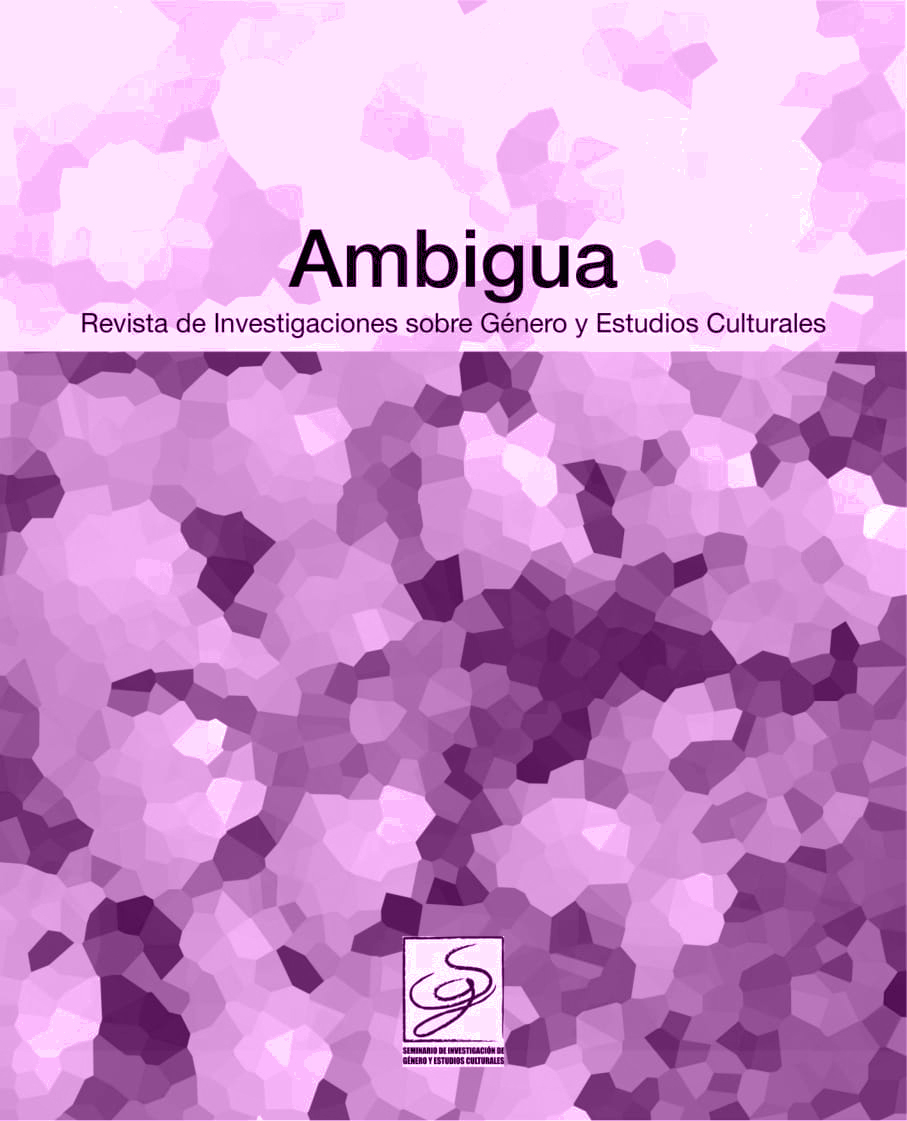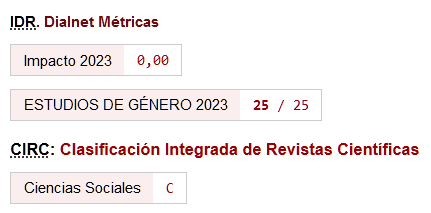Agression sexuelle et réification de la femme dans quelques romans féministes camerounais
DOI :
https://doi.org/10.46661/ambigua.4934Mots-clés :
identité, autonomisation , droit de la femme, œuvre d’art , approche genre, vision phallocratique, sociocritique , roman féministe , femme , agression sexuelleRésumé
Le roman féministe camerounais est un roman de combat. Il agit comme une forme de plaidoyer que formule l’écrivain en vue de la postulation des rapports sociaux de sexe plus dignes. Dans ce roman, le démiurge lutte pour l’avènement d’un ordre social plus juste au cœur duquel tous les genres se valent et tous les sexes se doivent un respect mutuel. Ce roman travaille dans plusieurs sens: redorer le blason de la femme en matière de droits et lui permettre de disposer de son propre corps comme une personne humaine respectée. Cet objectif de réappropriation du corps féminin bute cependant contre une certaine vision phallocratique des rapports de genre visant à maintenir la femme dans le giron sexiste. Dès lors, comme mode de déclinaison de la violence sexuelle, l’agression sexuelle ne participe-t-elle pas des stratégies dont la finalité n’est que la réification de la femme ? En nous inspirant de l’appareillage conceptuel sociocritique formalisé par Pierre Barbéris ainsi que l’approche genre, nous répondons à cette question de recherche. Le travail est organisé en trois parties. Dans la première, nous scrutons les formes de violence dont la femme fait les frais dans le texte féministe examiné. La deuxième partie porte sur la stylisation des violences sexuelles. Elle questionne les formes linguistiques à l’œuvre dans le texte littéraire, puisque l’œuvre littéraire se veut avant tout une œuvre d’art : par-delà la reproduction des faits observés, elle est production de langage. La dernière partie se préoccupe du message des romanciers ou encore leur vision du monde sur la question de l’agression sexuelle. Il s’agit dans cette partie de montrer que le viol constitue une grave enfreinte des droits de la femme, un obstacle majeur à son autonomisation et à l’affirmation de son identité.
Téléchargements
Références
Ahanda-Essomba, Honoré-Godefroy. Le Fruit défendu. Yaoundé: CLE, 1975.
Barbéris, Pierre. « La Sociocritique ». In Méthodes critiques pour l’analyse littéraire, edited by Daniel Bergez, Pierre
Barbéris, Pierre-Marc de Biasi, Luc Fraisse, Marcelle Marini, Gisèle Valency. Paris: Nathan, 1990, pp. 151- 182.
Barthes, Roland. Essais critiques. Paris: Seuil, 1964.
Bebey, Francis. La Poupée Ashanti. Yaoundé: CLE, 1973.
Beyala, Calixthe. Lettre d’une Africaine à ses sœurs occidentales. Paris: Spengler, 1995.
Bonono, Angéline Solange. Le Journal intime d’une épouse. Yaoundé: SOPECAM, 2007.
Bugul, Ken. Le Baobab fou. Paris: Présence Africaine, 2009.
Chesneau, Thierry. Basic Einstein. Paris: Mon Petit éditeur, 2010.
Chevrier, Jacques. L’Arbre à palabres. Paris: Hatier, 1989.
Cros, Edmond. Sociocritique. Paris: L’Harmattan, 2003.
De Beauvoir, Simone. Le Deuxième sexe. Paris: Gallimard, 1949.
Doubrovsky, Serges. Pourquoi la nouvelle critique ? Critique et objectivité. Paris: Mercure de France, 1966.
Forcolin, Francesca. « François Harvey, Alain Robbe-Grillet: le nouveau roman composite. Intergénéricité et intermédialité ». In Studi Francesi, 167 (LVI | II) | 2012, pp. 366-367.
Fraser, Nancy. « Multiculturalisme, anti-essentialisme et démocratie radicale : genèse de l’impasse actuelle de la théorie féministe ». In Cahiers du Genre. Paris: L’Harmattan, 2005, pp 31-45.
Krafft-Ebing, Richard Von. Psychopathia sexualis. Bloat Books, 1999.
Krauss, Cynthia. « “Avarice épistémiqueˮ » et économie de la croissance: le pas rien du constructionnisme social ». In Le Corps, entre sexe et genre, edited by Hélène Rouch, Elsa Dorlin, Dominique Fougeyrollas Schwebel. Paris: L’Harmattan, 2005, pp. 39-42.
Matlin, Margaret. Psychologie des femmes. Bruxelles: De Boeck, 2007.
Mitterand, Henri. Le Discours du roman. Paris: PUF, 1980.
Mpoudi Ngolle, Evelyne. Sous la cendre le feu. Paris: L’Harmattan, 1990.
N’guessan Kouadio, Germain. Féminisme: (en)jeux d’une théorie. Abidjan: Inidaf, 2017.
Ngo Iboum, Francine. Fleur brisée. Paris: L’Harmattan, 2011.
Nnomo, Marcelline. « Le genre: de la pensée de la différence à la postulation d’une catégorie d’analyse ». In Heuristique, Vol. 1, n° 2, 2013, pp. 11-25.
Onomo Abena, Sosthène. « El reencuentro. El retorno de un exiliado de Juan Balboa Boneke. Un roman-témoignage de dénonciation ». In Revue Syllabus, Vol. 1, n° 6. Yaoundé: PUY, 1998, pp. 81-98.
Sadamba, Tcha Koura. Femme infidèle. Lomé-Dakar-Abidjan: NEA, 1988.
Téléchargements
Publiée
Comment citer
Numéro
Rubrique
Licence
© Pierre Suzanne Eyenga Onana 2020

Ce travail est disponible sous licence Creative Commons Attribution - Pas d’Utilisation Commerciale - Partage dans les Mêmes Conditions 4.0 International.
Las autorías que publican en esta revista están de acuerdo con los siguientes términos:
- Los autores conservan los derechos de autor y garantizan a la revista el derecho de ser la primera publicación del trabajo al igual que licenciado bajo Licencia Creative Commons Atribución-NoComercial-CompartirIgual 4.0 Internacional la publicación inicial en esta revista: Attribution-NonCommercial-ShareAlike 4.0 International (CC BY-NC-SA 4.0)
- Las autorías pueden establecer por separado acuerdos adicionales para la distribución no exclusiva de la versión de la obra publicada en la revista (por ejemplo, situarlo en un repositorio institucional o publicarlo en un libro), con un reconocimiento de su publicación inicial en esta revista.
- Se permite y se anima a las autorías a difundir sus trabajos electrónicamente (por ejemplo, en repositorios institucionales o en su propio sitio web) antes y durante el proceso de envío, ya que puede dar lugar a intercambios productivos, así como a una citación más temprana y mayor de los trabajos publicados (Véase The Effect of Open Access) (en inglés).
- Esta revista no cobra por publicar, es decir, no tiene APC's (the journal does not have article processing charges)
- Esta revista tampoco cobra ninguna tasa por el envío/presentación de trabajos (the journal does not have article submission charges)









